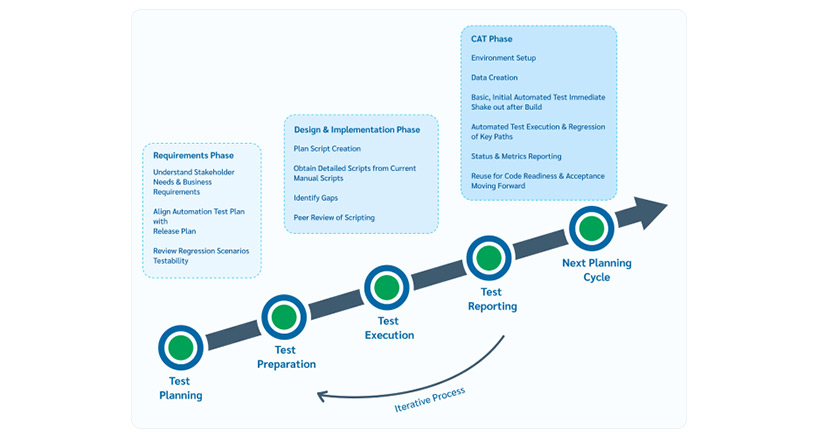SERVICESProfessional Services
Quality Assurance and Software Testing
QA and Testing is a critical step in any software or system launch. We follow a proactive and systematic approach to preventing defects and maintaining consistent quality throughout the software development process.
Assurety’s QA service establishes and enforces standards, guidelines and best practices to ensure adherence to requirements and promotes continuous improvement throughout the process. We identify and manage risks that could impact the quality or success for the software project and use that knowledge to improve the software during the testing services.
Because we understand business processes as well as technology, Assurety is uniquely positioned to develop rigorous testing requirements and perform thorough system checks with data sets similar to what the system may encounter in the real world.
Assurety follows a testing regimen that ensures a successful software launch. (See Figure 1) The first steps of the process include test planning and preparation where we speak to stakeholders, define processes, study system requirements, align the test plans and review regression scenarios.
We continue to develop the scheme during the design and implementation phases. The test scripts are written, reviewed and any gaps are identified prior to testing. Finally, the CAT phase includes setting up the environment, testing and reporting. Based on the information learned from the detailed reports, testing is revised and the scheme is run again with revised data to thoroughly test for deficiencies until the team is satisfied with the results.
While the majority of our testing is done manually, we employ automation of regression strategies to lower costs and provide a quicker turnaround when needed for larger projects. On very complex projects, Assurety leverages its expertise in development, functional and technical test use case strategies and s=automation framework along with software testing automation implementation to save labor costs and testing time.

Operational Optimization to Cut Labor Costs & Improve Service
Problem Statement: Large commercial carriers that use USPS for last-mile delivery consumed valuable time and resources when requesting appointments with USPS facilities. Each carrier, including FedEx, UPS and other logistics companies, used manual data entry to book dock time at each of the 250 intake facilities across the country, leading to high operational costs for USPS. Additionally, since the system was manual, there was no provision for electronic induction tracking, which was a key service performance indicator for USPS.
How we have helped our customers
CSDB – Marketing Advertisement Campaign Management
Problem Statement: USPS maintained only a single database with user information from a single source of sales data. The postal system sought a completely new system with deeper insights into customers that also allowed for marketing campaign management.
Intelligent Mail Barcode
Problem Statement: During the George W. Bush administration, Congress passed a law requiring USPS to gather data and track average delivery times, and to create incentives for the mailing industry to either invest more work-share or pay additional fees to maintain USPS cashflow.
Secure & Anonymous Addresses
Problem Statement: With the US population more mobile than ever, the cost to update address changes at USPS cost more than $5 billion per year. The postal service needed a solution that would cut the cost of updating address data while staying in compliance with PII regulations.
Customer Testimonials

“ Assurety has provided solutions definition, technical design, requirements development and management, Customer Acceptance Testing (CAT) support, and internal and external training for support for numerous systems and releases. ”
Pritha Mehra – Vice President

“Due to this extensive command on the subject, the consultants were able to develop rapport with our team, identify an analyse gaps in a short span of time.”
Lisa Sharpe – Director Enterprise Data Governance

“ Our customers like that the AIMS software is scalable and simple to use and it allows their staffs to become proficient with the product quickly. ”
Fred Sirkey – Vice President Business Development
